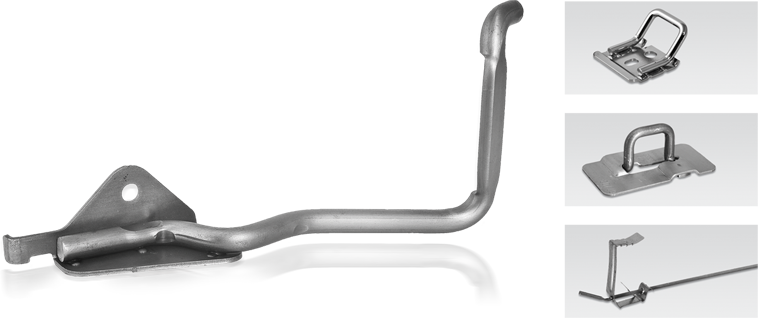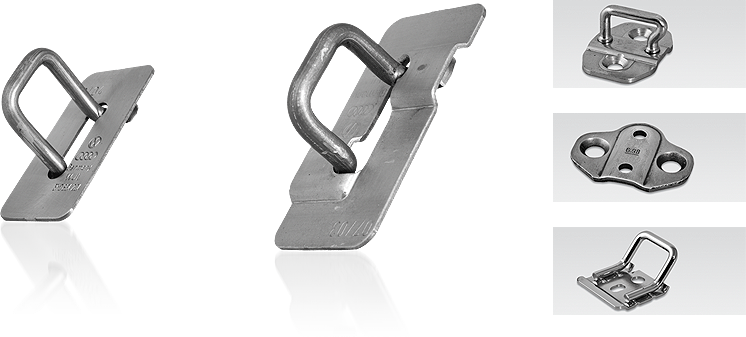| Stage I | Stage II |


End stage
Wire diameter 7/16“, bending, flattening at 360,000 lbs, strip from coil 2-3/4“ x 3/32“, 2.4 sec. cycle time, progressive die, welding at 100 kVA, series runs from 35,000 parts, finished part falling out, power requirement excl. welding approx. 25 kW
| Stage I | Stage II a | Stage II b |


End stage a | End stage b
Wire diameter from coil 1/4“, strip from coil 1/16“ x 1/4“, welding at 100 kVA, progressive die, 2.4 sec. cycle time, series runs from 25,000 parts, finished part falling out, power requirement excl. welding approx. 30 kW
Wire and strip
In the fabrication of metal parts, it is frequent to find applications that require the combination of a metal wire and a metal strip to achieve the desired results. Common manufacturing processes involved in the fabrication of these parts are wire and strip bending, wire flattening, strip punching, marking and welding to join them together. Here’s a brief overview of the most common processes performed on metal wires and metal strips.
Bending
Metal bending can be performed as a hot forming process or as a cold forming process. However, hot bending must be carefully performed, and it is more specific for certain applications because of the modifications that are introduced to the structure of the material due to the high temperatures required.
On the other side, cold bending is a more common process performed on metal wire and sheet metal strips, as they are ductile enough to be shaped by means of a press without any problem.
Although it can be performed manually with a hammer, cold bending is usually performed by using the force of a slider, a press or a finger bender. The piece of metal being formed is positioned on a die that will define the end shape of the part. Then, the metal is pressed on the die by the force of the ram to achieve the final shape.
Flattening
As the name suggests, it is the process of taking something with a round profile, like a metal wire, and making it flat. This can be done manually by hammering the wire, but a better result is usually achieved by means of a press in a cold forming process.
The application of this process is to allow for a change of profile in a given section of the part, moving from a round profile to a flat one.
Punching
Punching is a manufacturing process which is used to remove a part of the material with a specific shape and specific dimensions by means of a punch press. The shape and dimensions are defined by the tool used, which is called the punch. It is usually performed on sheet metal or metal strips, but it can be performed on any part with a flat section like the ones mentioned before. It is commonly used to create holes with specific diameters for assembly purposes.
Welding
Welding is a manufacturing process used to join metal parts by heating them in order to create the fusion of the materials. In addition to melting the area of the parts where they will be joined, known as base material, the process sometimes introduces another material to help create the joint, and this extra material is known as the filler. Similarly, some welding methods require an element to protect the materials from the environment while they are melted, and the most commonly used is a shielding gas.
The whole wire and strip manufacturing process
Traditionally, each process is performed independently, and they require specific tooling and operators for each of them. Of course, these requirements result in higher costs and reduced efficiency, which in turn means less productivity, a longer time to market and lower profitability.
To avoid the negative aspects of the activities described before, Schmale machines provide automated solutions that integrate all of the required processes into the same production cycle.
Schmale automated solutions can work on wire with a diameter of up to 1″ and strips with different dimensions in the same production cycle. The entire cycle takes only a few seconds, and the parts automatically moves through the different processes to generate the expected results.
Series runs begin at 20,000 parts, which clearly represents an enormous increase in efficiency and productivity and a significant reduction in the time to market, meaning that the profitability of your business will be higher.
To have a better view of the process please refer to the pictures and videos.
If you are looking for wire and strip manufacturing solutions integrated in a fully automated production process, or you have any further questions, please do not hesitate to contact us and we will gladly help you.
